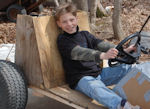One of the biggest headaches you will run into is an engine that keeps stalling and quitting. As an example I have two different snow blowers and they invariably quit during their operation especially in a really big snow storm!
They will run fine and then just start sputtering and die. I will then in my frustration start playing around with the carburetor adjustment jet thinking that is the problem.
The reason for quitting stems from lack of fuel. In order to get more fuel into the engine the logical adjustment would be to open up the richner screw.
This usually has its immediate effect, however the engine will soon lapse again into running rich then lean.
What is going on here?
Why is the engine causing such grief?
The answer lies in the float, not the adjustment screw.
The float is designed to regulate the flow of fuel into the carburetor. More specifically, the carburetor for it to dish out the proper amount of fuel for a wide range of operating rpms must have a reserve of fuel. This reserve is housed in the bowl of the carburetor.
The bowl would become overflowed if the fuel feed were not stopped. This stoppage is accomplished by the float attached to a needle..
What occurs is that the float literally floats in gasoline. When the level of the fuel gets to the proper level, the buoyancy of the float will press it against the needle and thus plug the fuel inlet hole.
So what does this have to do with the temperamental carb?
If the float is not set properly there will be two different possibilities:
1. Gas will keep leaking out of the carburetor
2. The engine will run out of gas, especially under hard acceleration
Another option is that the carburetor may not be sized properly for the engine, meaning when the engine is under load, it may run out of gas, because the reserve bowl is too small for the demands of the engine. (This can happen if you find carb in a parts bin and put it on any old engine.)
The plague of float bowl carburetors is that they must be run on level surfaces. If they are not, then they will start to starve when driven on hills. Because I live on a hill what occurs with the snow blowers is that the engine will run just fine going up a hill, but will quit going down a hill.
So there is nothing wrong with the carbs, just the terrain. To get around this problem, you need to understand what is occurring and get the engine level quickly when it starts to quit.
Below is a video that explains (in the latter part of it) the float and how it works in a caburetor. Also, included is how a caburetor functions, from the vacuum theory, throttle function, idler adjustment and choke principles.



great video , explained alot , thanks
i have a rockwell jlo 295cc engine with a walbro carb. the float appears ok, no pin holes and operates ok. my problem is i dont know the adjustments to the idle and main jet screws. i started by truning out the main at 1 3/4 and the idle at 1 1/2. thanks for the help geo